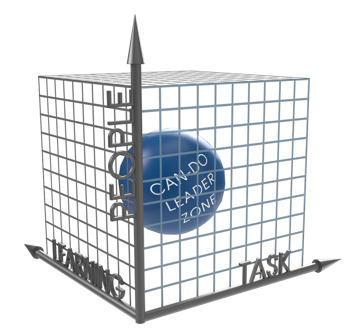ATD Blog
Being a Can-Do Leader: Want to Be on the Ball as a Leader? Think TPL!
Tue Jun 18 2013
In our last Being a Can-Do Leader blog post, “Too Much on Your Plate? Try Multi-Impacting,” we made the case for using the strategy, “purposeful multi-impacting,” as a way to get more done in less time. The essence of this strategy is for leaders to make decisions and pursue a course of action in ways that will simultaneously achieve more than one desired objective.
But, of course, when you are in a leadership position, your goal isn’t just to get more done in less time. More importantly, you want to make sure that you do the right things as a leader. This means that you need to purposefully focus on fulfilling your leadership responsibilities whenever possible.
Thinking TPL
So, how might you keep a purposeful focus on your leadership agenda? Chances are you’ve already had a quick look at The Answer. The answer, that is, in the form of the Can-Do Leadership Zone below. Now, let’s take a closer look at this ball-in-the-box graphic.

Can-Do Leadership Zone
This three-dimensional graph is an easy-to-remember representation of the fundamental people management responsibilities that all leaders inherit when they take on a management position.
The three axes are tagged “Task,” “People,” and “Learning.” They are meant to remind us that, if you are going to be the sort of leader who excels at building teams that can get the right things done with a high level of know-how and commitment, these areas will require your continual attention as a leader. For shorthand, we call giving appropriate attention to the relevant Task, People, and Learning issues as “Thinking TPL.”
Getting on the ball as a leader
Now, as for that ball in the box that we call the Can-Do Leader Zone, it is there to remind us that in order to get the right things done with enthusiasm and skill, leaders must continually give appropriate consideration to addressing the relevant task, people, and learning issues whenever they can. Give some consideration, that is, not just to one of these leadership dimensions, but to all three.
Reminding yourself to Think TPL can help you remember to do what needs to be done to lead your team into the Can-Do Zone.
Thinking TPL in real time
Nice theory you might say, but how might this actually work in practice? Here’s how Kim, a recently promoted manager in a Big Four accounting firm, put the Think TPL mantra to good use as she led her first big audit project.
Her boss told her right up front that, although he wanted her to continue to use her considerable auditing expertise to do some pieces of this project herself, now that she was in a leadership position she would ultimately be evaluated not only on how well her team performed, but also on her ability to develop the skills and capabiities of her team.
Mindful of the importance of getting her team into the Can-Do Zone, Kim realized right from the get go that continuing to remind herself to Think TPL would help her recognize opportunities to fulfill her leadership responsibilities.
Thinking T reminded Kim that whatever else happened, her job (first and foremost) was to get the audit done correctly and on time. At a minimum, Kim had the continuing responsibility to make sure that her team members were clear about tasks they needed to perform to achieve the desired results. Also, she would need to see to it that at critical junctures along the way the proper things were getting done.
Thinking P reminded Kim that several of her former peers who now reported to her have been frustrated and unhappy with their past project experiences at this firm. She would need to continue to find ways to help these particular team members get fully motivated to drive for high levels of performance. She did so by discussing with them what their main concerns had been, and seeking their advice on what would help them be more engaged and productive, given the realities of this project.
Thinking L reminded Kim to continue to make a conscious effort to find multiple opportunities to develop the current and future capabilities of her team. When she was doing work alongside her team members as a player/manager, she tried to teach as well as do (achieving T & L). More important, when Kim was considering who should do what (T & P), whenever possible she gave skill-building stretch assignments (L)—rather than always delegating assignments to her most skilled team members (achieving T, P & L).
By making Thinking TPL a habit—before swinging into action—you will keep focused on fulfilling your leadership responsibilities in a purposeful, systematic way in a wide range of situations. Do this, and you’ll always be on the ball as a leader!
Coming up next: Want an easy-to-remember acronym that will keep you properly focused when thinking about the people axis of our leadership model? Our next Can-Do Leader Blog, will show you how checking your team members’ VITALS will enable you to unleash an engaging Can-Do spirit.
You've Reached ATD Member-only Content
Become an ATD member to continue
Already a member?Sign In
